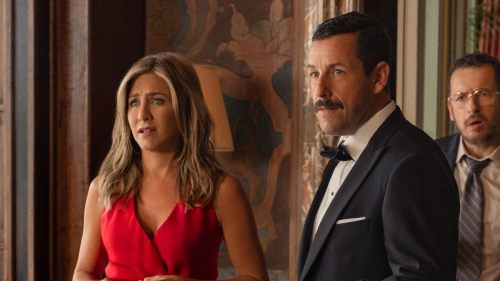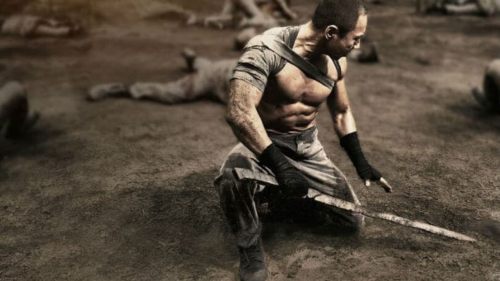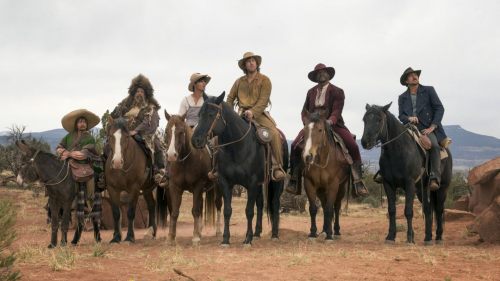ALTERED CARBON Review (Part II): Money Can’t Buy You Love
Here’s Part Two of our in-depth review of Netflix’s Altered Carbon - a show we thought merited a more comprehensive look than just one article. Jacob reviewed the first five episodes here, but if you’ve progressed further into the show (as many of you likely have), here’s a look at the back half of the season.
The first half of Netflix’s first season of Altered Carbon is a shotgun-blast of ideas. The show, like the book, explores a myriad of expressions of its central conceit, creating a futuristic, quasi-dystopian world that feels more real than many. Its central mystery - who killed Laurens Bancroft? - is as intriguing as the peripheral ones that feed into it, while the characters and setpieces we encounter along the way are consistently exciting.
Then, in episode six, the show undergoes a narrative reset: protagonist Takeshi Kovacs offers a made-up resolution to his employer Bancroft, and Kovacs’ sister Reileen re-emerges seemingly from the dead. I’ve seen people call this the start of a “second-half slump,” but in narrative terms, it’s a classic midpoint - reframing the central mystery, raising the emotional stakes, and refocusing the characters’ goals.
The reappearance of Reileen is the series’ most significant turn, both for the narrative - in which she becomes a new villain - and for Kovacs, whose loyalties are immediately challenged. Sadly, though, Rei's comically complicated plans don't really make all that much sense, at least where they involve her brother, and her villainy ends up playing as cartoonish cliche. It's a shame, because the siblings’ backstory - involving an abusive household and a strong brother-sister bond carried into rebellion and guerrilla warfare - is compelling. If the show is about Kovacs discovering an emotional core, his relationship with Rei is a significant part of that.
Shining much-needed light on that backstory is nearly an entire episode of flashbacks to Kovacs' rebel past. Glimpses of that are interwoven throughout the series, but seeing it all laid out, from his Protectorate training and exploitation to rebel recruitment to eventual capture, makes it all the clearer. The show made significant changes to this backstory - most notably in making the Envoys freedom fighters rather than UN enforcers - and it mostly works, making the central character(s) more sympathetic and adding an interesting wrinkle to the future history of the world. That history, it turns out, was written by the victors; in this version of the story, the Envoys are hated and feared thanks to propaganda. Hardly fair for a fighting force whose central philosophies are awareness and understanding of the self, the environment, and other people. If only Kovacs’ relationship with rebel leader Falconer were realised with as much depth, a second season would seem a lot more interesting.
Lieutenant Ortega also gets something of a reset, recovering from Episode 5's near-death attack with a bionic arm that’s handy for beating up crooked cops - and even handier for surviving cage matches with mutants. Likely the character who grew most on me, Ortega (a staunch, drily hilarious Martha Higareda) provides a welcome counterpoint to Kovacs’ nihilism. She manages to be The One Decent Cop In The Force without seeming preachy, and her family relationships feel genuine and authentic (presaging equally authentic emotional torment later on). Ortega also gets arguably the show's most insane fight scene, in which she takes on a gang of naked, katana-wielding Reileen clones (thankfully, in one of the episodes directed by a woman). And though she spends much of the final act in a virtual torture chamber, she certainly earns the ending she ends up receiving. I'd watch a show about this lady.
I'd also watch a show about the Elliot family, one area in which the show seriously improved over the more Kovacs-centric book. The Elliot family unit - Vernon (Ato Essandoh), Ava (Courtney Richter and Cliff Chamberlain), and previously-murdered Lizzie (Hayley Law) - is a rare beacon of love in this otherwise bleak show, and every moment we get to spend with them is a delight. Equally heartwarming is the depiction of “psychosurgery” not as some kind of invasive procedure, but as essentially therapy in a virtual world; that Edgar Allen Poe serves as Lizzie’s digital therapist is especially delightful. And though Lizzie's final-act turn to badass, fetish-clad avenger is predictable both narratively and in its visual language, the fact that the family gets an actual, proper happy ending makes up for it.
Altered Carbon's two-episode third act is an extended heist/confrontation aboard Reileen's hyper-exclusive, hyper-illegal flying brothel Head In The Clouds, and it's pretty great. A culmination of everything that's come before, it pulls the ripcord on nearly every narrative, thematic, and sci-fi element set up in the show. Double sleeving; cloning; synthetic bodies; Reaper poison; timed consciousness backups; Lizzie's rehab; faked religious coding; the Rawling mind-virus; Reileen; Ryker; the "ghost walker"; crooked cops; dear sweet Poe (RIP) - they all factor into a wildly entertaining conclusion. Playing out like a futuristic Mission: Impossible, with Kovacs backed by a capable team of oddball friends, the assault on Head In The Clouds is a daring, thrilling plan that's a joy to watch - especially when it goes wrong.
Thrilling, at least, except when it’s horrifying. After a season’s worth of innuendo, our look into the Meths’ floating palace of immoral hedonism reveals some of the show's worst horrors. Dealing in violent sex fantasies for the rich - only, thanks to hacked consciousness stacks, they're not fantasies at all - Head In The Clouds succeeds admirably in making us despise the show's villains. But the most nauseating moment comes not from the bloodbaths we see, or even a priestlike host's offer of child sex slaves - it's in the dialogue delivered by one of the institution's doomed real-death prostitutes. Her pleading insistence that Vernon (under a cover identity) brutally slay her - or else she'll get fired! - conjures up imagery worse than any that could be realised onscreen; imagery nobody wants to have projected on the back of their mind.
It’s in the back half of the season that Altered Carbon's major statements come to the fore. Though set against a thematic backdrop of consciousness, physicality, and identity, this season's story is really about class and inequality. From the incidental world-building - including a terrific sequence in which Kovacs literally spits on, then punches, a wildly commercialised private healthcare system - to the actual plot, Altered Carbon's first season presents wealth as inextricably married to unfathomable, unapologetic amorality. Human lives are expendable in the future 1%’s pursuit of ever more novel debauchery. Tragically, the only thing separating Head In The Clouds from sex crimes happening in the real world is a veneer of science fiction.
The same goes for the Meths’ view of themselves as immortal gods to be worshipped by the lowly. How far removed are we from that scenario, when Silicon Valley types pour money into life-extension research and engage in regular drug-fueled orgies while building fawning public cults of personality around themselves? Altered Carbon depicts eternal life (at least, when coupled with eternal resources) as an inevitable slide into damnation, and it's hard to argue with that. At least these people clearly all hate each other - and themselves. “We've ruined each other, haven't we?” asks Miriam, rhetorically, as both Bancrofts are arrested, their souls irretrievably sick. Unlike Kovacs, who chooses to retain his painful memories, the Bancrofts are desperate to erase the things they’ve done. But they can only erase their memories, not their acts; justice, ultimately, is served. If only that was the case in real life.
A second season of Altered Carbon is yet to be confirmed, and by no means guaranteed, given how outrageously expensive this show must be. I mean, did you see the size of those standing sets? The scale of that climactic airship crash? That jaw-dropping, long-take tracking shot with two Joels Kinnaman in it? That stuff doesn't come cheap.
But if Season 2 does eventuate, there's much to be explored. Two further novels exist to draw from - some of their material already made it into this season - and the finale’s ending suggests a hunt for Quellcrist Falconer is on the cards. Numerous tantalising concepts flitted around the show's edges throughout season one, like ancient aliens and interstellar travel, and could certainly come into play later. Most exciting of all: like Doctor Who, the show has a built-in mechanic for recasting its lead roles - and though Joel Kinnaman did a fine, droll job as this season's primary Kovacs (ably supported by other actors in flashback), it would be fun to see the role evolve in a different sleeve.
This is a universe packed with weird, fascinating, unsettling ideas and imagery, and I can't wait to see more of it. But if Altered Carbon ends here, it does so with a mostly successful, self-contained first season - one filled with action, imagination, and a surprising amount of empathy. Not many shows can claim that.



